“If I’ve to give another bale to cows out the field… if it gets bad again, we’re screwed.”
Harry Lalor’s response to the all too common question at present – ‘how are you for silage?’
The twenty-odd silage bales left in the yard are needed for the remainder of Harry’s finishing stock – bulls, cull cows and heifers.
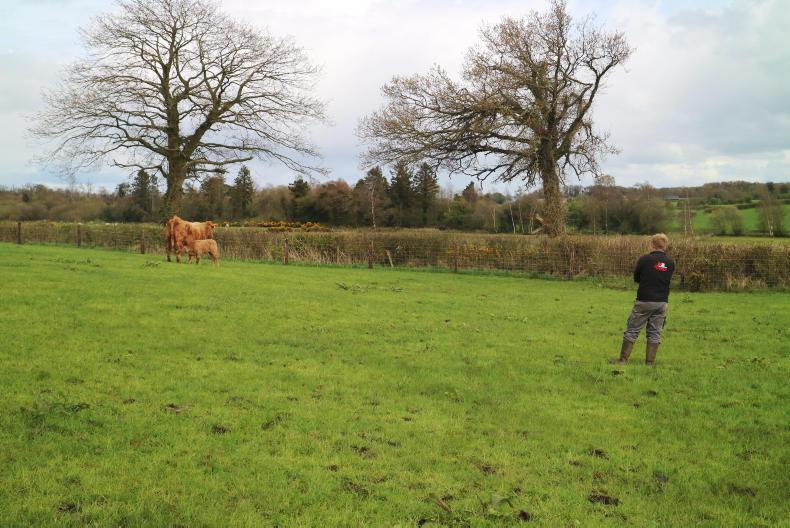
Harry Lalor keeps an eye on a young calf who was slow to rise. Harry’s system involves beefing bulls at 20 months, after turning out to grass as yearlings and coming back in for finishing in late-summer/autumn.
A recent dietary change has run smoothly for Harry’s bulls. His supply of fodder beet has run out and concentrates and silage have been increased in its place.
“I’m surprised at how little extra silage they’re eating. The dung looks fine and they seem content,” Joe, Harry’s father, told me.
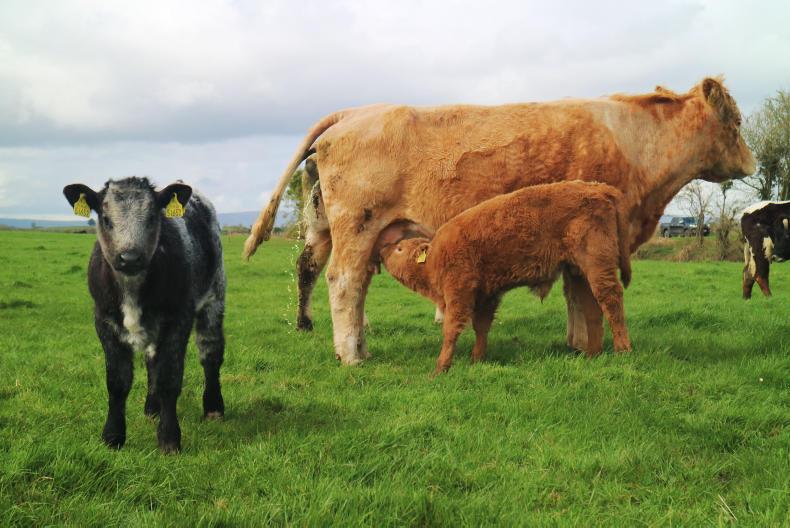
Saler bull calf born 2 March from a Belgian Blue cow.Clap happy
When looking at cattle dung as an indicator of nutritional health, using our ears can be helpful too. Walk into a shed, put the animals up and listen for dunging. It should sound like someone clapping their hands in a slow, steady fashion – with three to five impacts.
Grass has flown in recent weeks, with Harry recording growth of 72kg DM/ha/day up to the weekend. There are 49 acres closed for silage, with fertiliser spread on Saturday 22 April.
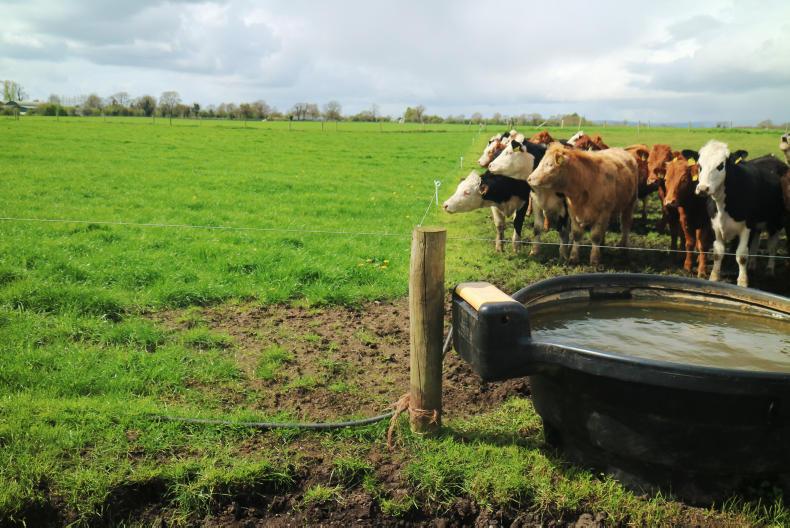
Breeding heifers ready for a move to fresh grass. A Saler bull will run with these.The pair spread 120 units of nitrogen in the form of cut sward (24-2.5-10). While it seems high given the date, Harry will be monitoring nitrogen levels in the crop before making the decision to cut. Joe feels that it will be 10 June when they’re cutting – around a week behind normal.
“You’d hope a big burst of growth would come and use up the nitrogen. The aftergrass will be important for lambs,” Harry told me.
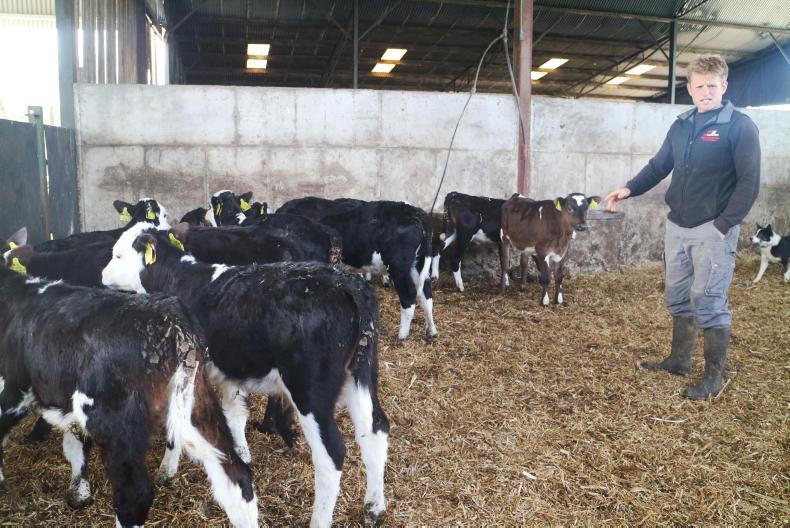
Harry Lalor going through his dairy beef batch. There are nine left to calve on the farm. Out of 106 calvings, there were 13 losses in what was a frustrating spring period. There was no single underlying issue responsible, merely bad luck. There were two abortions, from which lab samples returned no obvious causes. One death was caused by an umbilical cord problem. Two cows lay on calves and there was one case of pneumonia. Another calf died in the field and a PM returned ulcers on the liver, while one succumbed to a navel infection caused by a bacteria that showed no clinical signs (no swelling).
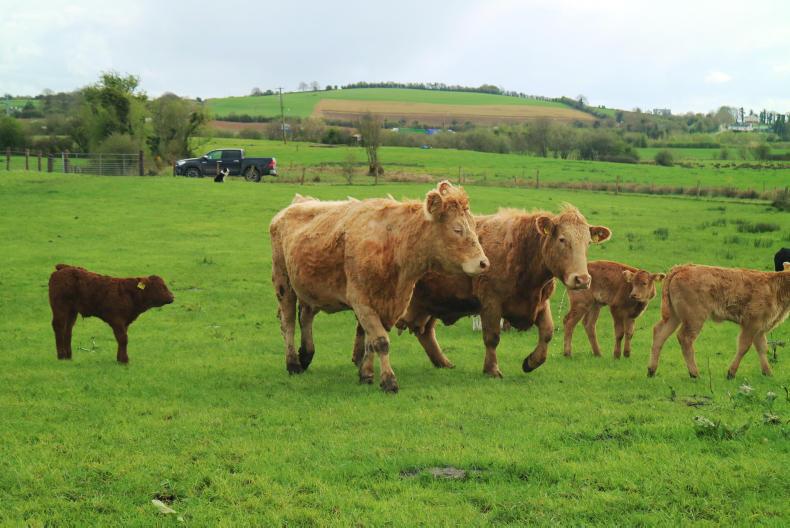
Harry Lalor's sucklers on their way to a fresh paddockHowever, there are only five idle cows at present and these are being culled. Harry buys in calves for rearing every year from a neighbouring dairy farmer. He has fostered some of these onto cows that lost calves.
“The plan for breeding this year is to cull hard. We have 40 heifers going to the bull. A lot of these cows that lost calves or other problem cows already have strikes against them I find. Having lots of heifers gives us options. The strongest dairy-bred (Hereford-cross) calves are included in this – there are 19 of them that I’m going to try.”
Heifers will run with Harry’s Saler bull – a Vanlooy son from a Rio cow.
BETTER farm labour analysis
Profiling Harry and Joe Lalor
First visit with Harry Lakir
“If I’ve to give another bale to cows out the field… if it gets bad again, we’re screwed.”
Harry Lalor’s response to the all too common question at present – ‘how are you for silage?’
The twenty-odd silage bales left in the yard are needed for the remainder of Harry’s finishing stock – bulls, cull cows and heifers.

Harry Lalor keeps an eye on a young calf who was slow to rise. Harry’s system involves beefing bulls at 20 months, after turning out to grass as yearlings and coming back in for finishing in late-summer/autumn.
A recent dietary change has run smoothly for Harry’s bulls. His supply of fodder beet has run out and concentrates and silage have been increased in its place.
“I’m surprised at how little extra silage they’re eating. The dung looks fine and they seem content,” Joe, Harry’s father, told me.

Saler bull calf born 2 March from a Belgian Blue cow.Clap happy
When looking at cattle dung as an indicator of nutritional health, using our ears can be helpful too. Walk into a shed, put the animals up and listen for dunging. It should sound like someone clapping their hands in a slow, steady fashion – with three to five impacts.
Grass has flown in recent weeks, with Harry recording growth of 72kg DM/ha/day up to the weekend. There are 49 acres closed for silage, with fertiliser spread on Saturday 22 April.

Breeding heifers ready for a move to fresh grass. A Saler bull will run with these.The pair spread 120 units of nitrogen in the form of cut sward (24-2.5-10). While it seems high given the date, Harry will be monitoring nitrogen levels in the crop before making the decision to cut. Joe feels that it will be 10 June when they’re cutting – around a week behind normal.
“You’d hope a big burst of growth would come and use up the nitrogen. The aftergrass will be important for lambs,” Harry told me.

Harry Lalor going through his dairy beef batch. There are nine left to calve on the farm. Out of 106 calvings, there were 13 losses in what was a frustrating spring period. There was no single underlying issue responsible, merely bad luck. There were two abortions, from which lab samples returned no obvious causes. One death was caused by an umbilical cord problem. Two cows lay on calves and there was one case of pneumonia. Another calf died in the field and a PM returned ulcers on the liver, while one succumbed to a navel infection caused by a bacteria that showed no clinical signs (no swelling).

Harry Lalor's sucklers on their way to a fresh paddockHowever, there are only five idle cows at present and these are being culled. Harry buys in calves for rearing every year from a neighbouring dairy farmer. He has fostered some of these onto cows that lost calves.
“The plan for breeding this year is to cull hard. We have 40 heifers going to the bull. A lot of these cows that lost calves or other problem cows already have strikes against them I find. Having lots of heifers gives us options. The strongest dairy-bred (Hereford-cross) calves are included in this – there are 19 of them that I’m going to try.”
Heifers will run with Harry’s Saler bull – a Vanlooy son from a Rio cow.
BETTER farm labour analysis
Profiling Harry and Joe Lalor
First visit with Harry Lakir











 This is a subscriber-only article
This is a subscriber-only article






















SHARING OPTIONS: